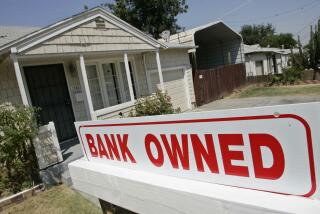HomeFed Earmarks $115-Million ‘Cushion’ : Thrifts: The savings institution hopes a loan-loss reserve set aside in the fourth quarter will renew confidence in its weakened stock. The company also plans to quickly liquidate $350 million in foreclosed real estate.
SAN DIEGO — In a move to shore up investor confidence after a precipitous two-month slide in its stock price, HomeFed Corp. said Friday that it will set aside loan-loss allowances totaling $115 million for the fourth quarter ending Dec. 31.
HomeFed President Robert Adelizzi said the amount is not a specific provision for problem loans but a “general” loan-loss allowance to “provide a cushion for events that may occur based on historic performance.” Prospects for a slowing economy helped persuade HomeFed to take the allowance, he said.
The allowance will also give HomeFed, the San Diego-based parent of HomeFed Bank, more flexibility in carrying out its plan to “liquidate on a more rapid basis” $350 million in foreclosed real estate properties, he said.
Likened by analysts to the $200 million set aside by Great Western Bank earlier this week to cover probable writedowns and loan losses, the provision is meant to assure the investment community that HomeFed has adequately reserved for loan problems, said Allan Bortel, an analyst with the Shearson Lehman Hutton investment firm in San Francisco.
HomeFed stock has been battered in recent weeks, falling from a 1989 high of $47.50 in early October to close at $29.125 in Thursday trading, a 39% drop. The stock market reacted favorably to Friday’s announcement, as HomeFed stock closed Friday at $30.75, up $1.625 in New York Stock Exchange trading.
The stock slide was hastened in October when HomeFed announced a dip in earnings and that its problem loans and foreclosed real estate had jumped to 2.85% of total assets as of Sept. 30, up from 2.45% of assets three months previous. A high percentage of non-performing loans tends to diminish an S&L;’s earning power.
Moreover, the stocks of HomeFed and other savings and loans have suffered by Wall Street’s fears that the California real estate market is softening and that the state’s economy will suffer from expected cuts in defense spending, said Dan Williams, an analyst with Sutro & Co. investment firm in San Francisco.
S&L; stocks have also suffered from the tough new capital standards imposed on the industry by the S&L; rescue bill passed by Congress last summer. By making acquisitions more difficult, the capital requirements have worked to delay the long-anticipated “consolidation” that was expected to hit the S&L; industry once the bail-out package was resolved, Williams said.
“There are few enough potential buyers among the thrifts themselves that they are taking the view that it’s a buyer’s market and that there’s no rush,” Williams said. “A lot of S&Ls; will be available to be bought because (the troubled S&Ls;) don’t have a lot of choice except to be acquired.”
Bortel of Shearson Lehman Hutton described the $115-million loss allowance as a “catharsis” that will turn HomeFed stock around in coming months.
HomeFed said the after-tax effect of the loan-loss allowance will be a $68-million charge on fourth-quarter earnings. That charge will be largely offset by a $62-million after-tax benefit resulting from the merger of HomeFed subsidiary Columbus Savings into HomeFed Bank, which was also announced Friday.
Adelizzi said the loan-loss allowances, which should bring HomeFed’s non-performing assets down to about 2.2% of total assets, will “assuage (investor) concerns about the California real estate market and our ability to manage through any potential recession that may occur.”
HomeFed decided to “move those (foreclosed properties) out more quickly” in light of new risk-based capital standards that require S&Ls; to have roughly twice the capital on hand for foreclosed property as for real estate loans. The requirement gives S&Ls; more incentive to get the foreclosures off their books, Adelizzi said.
Columbus Savings, a $700-million thrift with 14 branches in the San Francisco Bay Area, was acquired by HomeFed late last year but had been operated as a separate subsidiary. By folding Columbus into HomeFed, the S&L; is entitled to use Columbus’ $170 million in tax-loss carryforwards, an action that will result in an after-tax benefit of $62 million in the fourth quarter, Adelizzi said.
More to Read
Inside the business of entertainment
The Wide Shot brings you news, analysis and insights on everything from streaming wars to production — and what it all means for the future.
You may occasionally receive promotional content from the Los Angeles Times.









